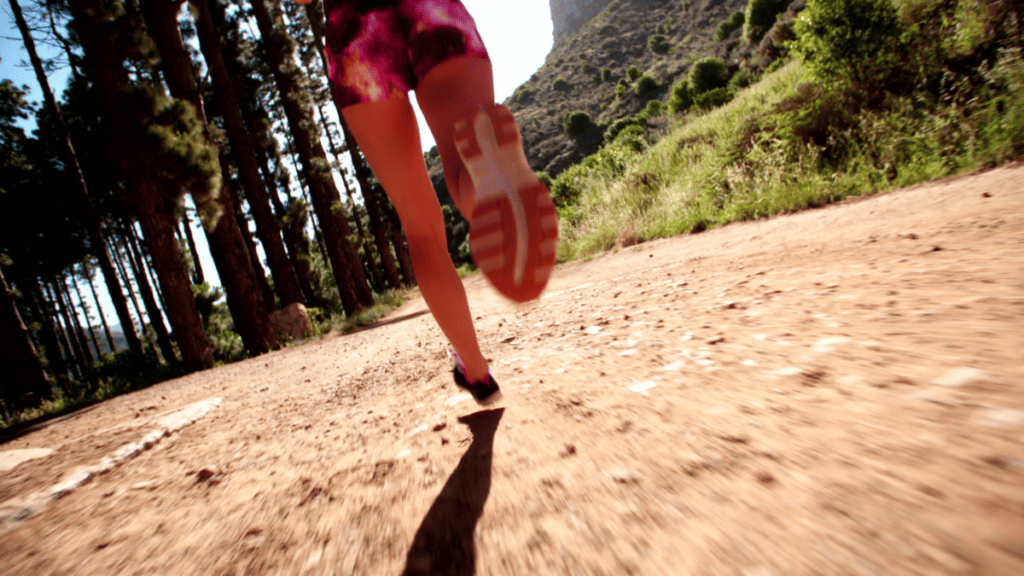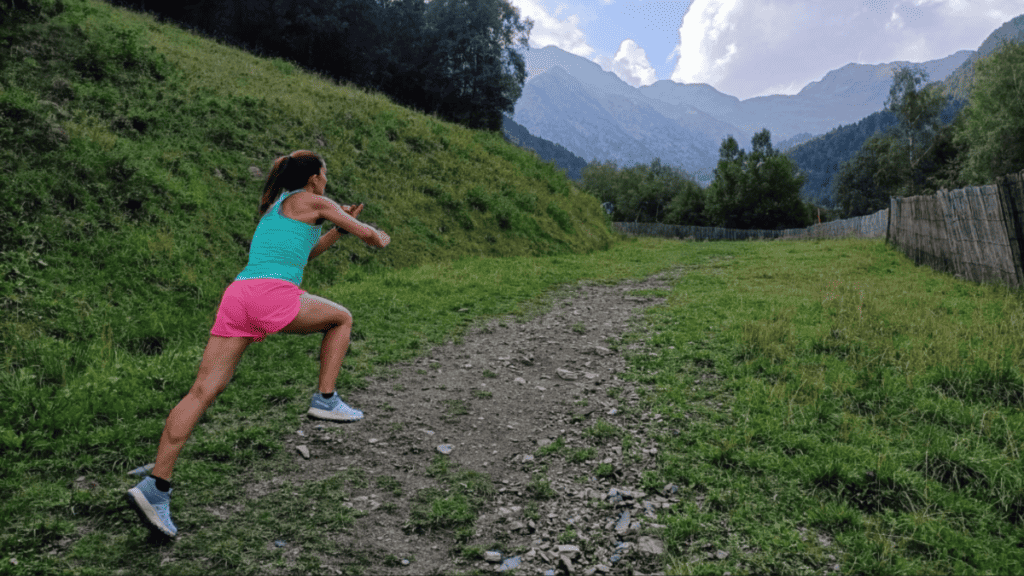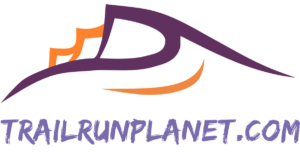
I must admit that when I was a young runner I never had any calf muscle pain and certainly not anything like I have suffered in recent years. The biggest difference back then was that our coach kept us on a year-round program of high volume as distance runners, adding speed at specific parts of each season. As an adult, I tend to take extended periods off and then try and come back quickly with a short program of volume and intensity – and get hurt.
Calf muscles play a vital role in running by providing both propulsion and stability. When these muscles are overworked or strained, pain can occur. It takes longer to improve calf muscle strength than cardio fitness meaning that you can overload the muscles when pushing to improve cardio fitness.
Let’s take a closer look at what causes our calves to hurt when we run and what we can do to prevent it from getting so bad that it stops us from making progress.
Why Do MY Calves Hurt When I Run
To understand why your calves hurt when you run, it’s crucial to delve into the intricate anatomy and biomechanics of these muscles. The calf muscles, including the gastrocnemius and soleus, play a vital role in the running gait cycle by providing propulsion and stability. When these muscles are overworked or strained, pain can occur.
One common reason for calf pain during running is overuse. Excessive running without proper rest can lead to muscle fatigue and strain. Additionally, biomechanical issues such as improper running form or foot alignment can put extra stress on the calves, resulting in discomfort.
Another factor to consider is inadequate footwear. Ill-fitting or worn-out shoes can fail to provide proper support and cushioning, leading to increased impact on the calf muscles.
By understanding the demands placed on the calf muscles during running and addressing potential issues such as overuse, biomechanical imbalances, and footwear choices, you can take proactive steps to alleviate calf pain and enhance your running experience.
Understanding Calf Muscle Function
The calf muscles, specifically the gastrocnemius and soleus, are essential players in the running gait cycle. They work together to provide the necessary propulsion and stability during each stride. The gastrocnemius, the larger of the two muscles, is responsible for generating power during push-off, while the soleus, located underneath the gastrocnemius, helps maintain stability and control the movement of the ankle.
During the running gait cycle, the calf muscles undergo a series of contractions and relaxations to propel the body forward. As the foot pushes off the ground, the calf muscles contract, lifting the heel and propelling the body forward. This action is crucial for maintaining speed and efficiency during running.
Understanding the intricate role of the calf muscles in the running gait cycle is key to comprehending why they may experience pain or discomfort during running activities. By delving into how these muscles contribute to propulsion and stability, runners can better appreciate the importance of proper care, training, and biomechanics to prevent issues such as calf pain and injuries.
Impact of Running Surface on Calf Pain
Different running surfaces can have a significant impact on calf muscle strain during running. The surface you choose to run on can either alleviate or exacerbate calf pain and discomfort. For instance, running on hard surfaces like concrete can increase the strain on your calf muscles due to the lack of shock absorption, leading to a higher risk of injury and pain. On the other hand, softer surfaces like grass or trails provide more cushioning and shock absorption, reducing the impact on your calves and decreasing the likelihood of strain.
Each surface presents unique challenges and benefits for calf muscles. Concrete, while convenient and accessible, can be harsh on the calves, especially during long-distance runs. Grass offers a softer landing, which can be gentler on the calf muscles and reduce the risk of overuse injuries. Trails, with their varying terrain and natural obstacles, provide an excellent opportunity to engage different muscle groups in the calves, promoting strength and stability.

Understanding how different running surfaces affect calf muscle strain is crucial for runners looking to prevent pain and injuries. By choosing the right surface and adjusting running techniques accordingly, runners can minimize calf strain and enjoy a more comfortable and injury-free running experience.
Importance of Proper Footwear
Proper footwear plays a crucial role in preventing calf pain and injuries while running. The right shoes can provide adequate support, cushioning, and stability to reduce the strain on your calf muscles. “Choosing the correct running shoes” that are specifically designed for your foot type and running gait can help distribute the impact of each stride more evenly, minimizing the stress on your calves. Additionally, proper footwear can help maintain proper alignment of the foot and ankle, reducing the risk of overuse injuries such as Achilles tendonitis or calf strains.
Moreover, “worn-out or ill-fitting shoes” can contribute to calf pain by altering your running mechanics and increasing the strain on your calf muscles. It is essential to regularly assess the condition of your running shoes and replace them when they show signs of wear and tear. Investing in high-quality, supportive footwear tailored to your individual needs can make a significant difference in preventing calf pain and ensuring a comfortable running experience.
Signs of Overuse and Overtraining
Overuse injuries in the calves can manifest in various ways, indicating the need to address training intensity and recovery strategies. One common sign is persistent pain or tenderness in the calf muscles, which may worsen during or after running. Additionally, swelling, redness, or warmth in the calf area can signal inflammation due to overuse. It’s essential to pay attention to any sharp or stabbing pain, as this could indicate a more severe injury like a calf strain.
Another sign of overtraining is a decrease in performance despite consistent training efforts. If you notice a sudden decline in your running abilities or increased fatigue in the calves, it may be a sign that you are pushing your muscles beyond their limits. Furthermore, recurring calf cramps or tightness that doesn’t improve with rest can be a red flag for overtraining.
By recognizing these signs early on, runners can adjust their training routines, incorporate proper rest and recovery, and seek professional help if needed to prevent more severe injuries and ensure long-term muscle health.
Stretching and Warm-Up Techniques
To prevent calf pain and injury while running, it is crucial to incorporate effective stretching and warm-up techniques into your routine. Prior to your run, focus on dynamic stretches that target the calf muscles, such as calf raises, ankle circles, and leg swings. These movements help increase blood flow to the muscles and improve flexibility, reducing the risk of strains or tightness during your run.
Additionally, performing a light jog or brisk walk for 5-10 minutes before starting your run can further warm up the calf muscles and prepare them for the upcoming activity. This gradual increase in intensity helps prevent sudden stress on the muscles, decreasing the likelihood of pain or discomfort.
Remember to hold each stretch for 15-30 seconds and perform them on both legs to ensure balanced flexibility. Incorporating these stretching and warm-up exercises into your pre-run routine can help optimize your performance, reduce the risk of calf pain, and enhance overall muscle health.
Strengthening Exercises for Calves
To enhance calf muscle endurance and prevent fatigue-related pain, incorporating a variety of strengthening exercises into your workout routine is essential. One effective exercise is calf raises, where you stand with your feet hip-width apart and slowly raise your heels off the ground, then lower them back down. This exercise targets the calf muscles and helps build strength and endurance.
Another beneficial exercise is the seated calf raise, which involves sitting on a chair with your knees bent at a 90-degree angle and placing a weight on your thighs. Lift your heels off the ground by pushing through the balls of your feet, then lower them back down. This exercise focuses on the soleus muscle in the calf, contributing to overall calf strength.
Additionally, incorporating jump rope exercises can help improve calf muscle endurance and agility. Jumping rope engages the calf muscles while also providing a cardiovascular workout. Aim to gradually increase the intensity and duration of your jump rope sessions to challenge and strengthen your calf muscles effectively.
By including these strengthening exercises in your regular workout routine, you can enhance calf muscle endurance, reduce the risk of fatigue-related pain, and improve overall lower leg strength.
Addressing Biomechanical Imbalances
Biomechanical issues play a crucial role in understanding the root causes of calf pain during running. One common biomechanical problem is overpronation, where the foot rolls inward excessively during the gait cycle. This can lead to increased stress on the calf muscles, resulting in pain and discomfort. By addressing overpronation through proper footwear or orthotic inserts, runners can help alleviate calf pain and prevent injuries.
Moreover, tightness in other muscle groups, such as the hamstrings or hip flexors, can also contribute to calf pain. When these muscles are tight, they can alter the mechanics of running, placing additional strain on the calf muscles to compensate. Incorporating regular stretching routines targeting these muscle groups can help improve flexibility and reduce the likelihood of calf pain.
Understanding and addressing biomechanical imbalances are essential steps in managing calf pain while running. By identifying and correcting issues like overpronation and muscle tightness, runners can improve their overall biomechanics, reduce the risk of calf injuries, and enhance their running performance.
Hydration and Nutrition for Muscle Health
Proper hydration and nutrition are vital components in maintaining optimal calf muscle health and preventing cramping while running. Hydration plays a crucial role in muscle function, as dehydration can lead to muscle fatigue and cramping. It’s essential for runners to stay well-hydrated before, during, and after their runs to support muscle performance and recovery. Electrolyte-rich drinks can be particularly beneficial in replenishing lost minerals and preventing imbalances that may contribute to calf cramps.
In terms of nutrition, a well-balanced diet rich in essential nutrients like potassium, magnesium, and calcium is key for muscle health. These nutrients support muscle contraction, relaxation, and overall function, helping to reduce the risk of calf pain and cramping during running. Incorporating foods such as bananas, leafy greens, nuts, and lean proteins can provide the necessary nutrients to support calf muscle health.
By paying attention to hydration levels and maintaining a nutritious diet, runners can support their calf muscles, reduce the likelihood of cramping, and enhance their overall running performance. Prioritizing hydration and nutrition as part of a holistic approach to muscle health can help runners enjoy a more comfortable and successful running experience.
Recovery Strategies for Calf Pain
After a strenuous run, implementing effective recovery strategies is crucial to alleviate calf soreness and prevent injury. One beneficial technique is foam rolling, which helps release tension in the calf muscles by applying pressure to trigger points. By incorporating foam rolling into your post-run routine, you can improve blood flow, reduce muscle tightness, and enhance overall flexibility, promoting faster recovery.
Another valuable recovery strategy is massage therapy, which can target specific areas of tightness or discomfort in the calves. A professional sports massage or self-massage technique can help increase circulation, reduce inflammation, and promote muscle relaxation, aiding in the recovery process.
In addition to foam rolling and massage, allowing for proper rest and recovery time is essential for calf muscle repair and growth. Adequate rest enables the muscles to recover from the stress of running, reducing the risk of overuse injuries and chronic pain. Incorporating rest days into your training schedule and prioritizing quality sleep can significantly contribute to the healing and strengthening of your calf muscles.
By incorporating foam rolling, massage therapy, and sufficient rest into your post-run routine, you can effectively manage calf soreness, enhance muscle recovery, and optimize your running performance.
When to Seek Professional Help
When experiencing persistent or severe calf pain during running, it is crucial to know when to seek professional help. If you find that the discomfort in your calves is not improving with rest, stretching, or other self-care measures, it may be time to consult a healthcare professional. Additionally, if the pain is sharp, intense, or accompanied by swelling, redness, or warmth in the calf muscles, it could indicate a more serious issue that requires medical attention.
Another key indicator that it’s time to seek professional help is if the calf pain is impacting your daily activities or significantly hindering your ability to run. A healthcare provider, such as a sports medicine physician, physical therapist, or orthopedic specialist, can conduct a thorough evaluation to determine the underlying cause of the calf pain and recommend appropriate treatment options.
Remember, early intervention and proper diagnosis are essential for preventing further injury and promoting effective recovery. By seeking professional help when needed, you can address calf pain more effectively and get back to running pain-free sooner.
Tips for Preventing Future Calf Pain
To prevent future calf pain during workouts and races, it is essential to focus on proper prevention strategies. Firstly, ensure you have the right “footwear” that provides adequate support and cushioning for your calves. Ill-fitting shoes can contribute to muscle strain and discomfort. Secondly, incorporate “hydration” and proper “nutrition” into your routine to support muscle health and prevent cramping.
Additionally, prioritize a thorough “warm-up” routine before running to prepare your calf muscles for the activity. Dynamic stretches that target the calves can help prevent injuries. After your run, don’t forget to “stretch” your calves to promote flexibility and reduce tightness.
Furthermore, consider incorporating “strengthening exercises” specifically for the calves into your training regimen. Building strength in these muscles can help prevent overuse injuries and improve performance. Lastly, listen to your body and “rest” when needed to allow for proper recovery and avoid pushing through pain that could lead to future issues. By implementing these tips, you can proactively reduce the risk of calf pain and enjoy your runs more comfortably.
